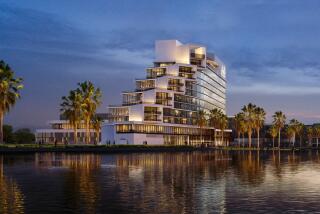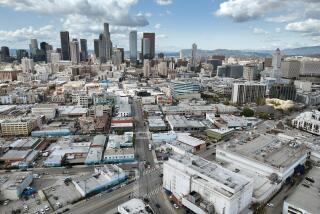New Hotels Help National City Fool the Critics Again
- Share via
National City, the South Bay community that marches to its own drummer, is proving the critics wrong--again--and giddy city leaders are pointing with pride to two new hotels that experts said would never prosper in the blue-collar town.
For now, the recently opened Radisson Hotel stands alone, alongside Interstate 5, its 10 floors looming on the horizon, a symbolic thumbing of National City’s nose at the doomsayers. A 12-story hotel, as yet unnamed, is under construction across the way at 8th Street and National City Boulevard, in an area that many said could not support even one hotel.
“Two market researchers told us eight years ago that the market isn’t there for one hotel at that corner. We thanked them for their opinions, paid them their fees, disregarded their recommendations and commissioned two hotels,” said Arnold (Pete) Peterson, executive director of National City’s redevelopment agency.
Although the $12-million Radisson has been open only three months, owners say it has succeeded beyond their most optimistic projections, and they predicted “breaking even” within the year. The Serj Corp., which owns the 180-room Radisson and 3.7 acres of redevelopment land around it, said it expects to finish the second, $18-million hotel with its 176 suites in the fall.
Gary London, director of the real estate division at the Price Waterhouse accounting firm, was one of the experts who recommended against building hotels on the site. In a recent interview, London said he was right when he made that recommendation, but added that he is glad National City officials disregarded his advice.
“The past is not necessarily a prologue of the market in National City,” London said. “ . . . In redevelopment, timing is a very critical thing. Many people have had great ideas but no sense of timing. National City has always had an uncanny sense of timing.”
In this case, National City and the Radisson have profited from the San Diego Convention Center, which was not a reality when he did the study, London said.
Peterson, who has guided National City’s redevelopment for 15 years, said the city was taking a risk when it went against the experts’ recommendations. City leaders were banking on the Convention Center being built someday and wanted to create a market for conventioneers who couldn’t afford to stay in San Diego’s high-priced hotels.
London, who is also a redevelopment expert, marvels at National City’s redevelopment successes, including its landmark Mile of Cars and the Plaza Bonita Shopping Center. The latter was also built despite warnings from some critics that the South Bay economy could not support another regional shopping center.
“The city’s reputation, whether real or not, is that it’s middle-class at best, but probably lower-class,” London said. “The truth is that National City is very progressive and a hidden jewel in the redevelopment area. . . . The city leaders’ vision isn’t very sophisticated, but, intuitively, it’s very good. They always seem to know what does and doesn’t work in their city.”
Serj Corp. President Jack Scull said current rates at the new Radisson are $55 a night. Ironically, he said that when his company “decided to take a chance” and build the hotels, they were not counting on convention visitors. Instead, Scull said they were hoping to attract mainly clients from the Navy, the waterfront and Mexico.
The fact that the two hotels are about 10 minutes away from the Convention Center and downtown San Diego were an added plus, he said. Of course, it helps that Radisson’s parent company also owns one of the biggest travel agencies in the United States.
Serj has a Radisson franchise and contracted with the firm to manage and operate the hotel.
“The Radisson is the only hotel you can see between San Diego and the border. It sticks out as a 10-story building. We’re not just sitting there hoping someone will come in. Our marketing strategy includes Nassco (National Steel & Shipbuilding Co.), the Navy and Mexico. And it appears to be working,” Scull said.
He declined to reveal the Radisson’s occupancy rate. The hotel industry says new hotels need a daily occupancy rate of 65% or higher in order to survive. The San Diego Convention and Visitors Bureau does not keep occupancy rates by individual cities, but it put the December rate at 53.5% for the South Bay, including National City.
National City community activist Ron Morrison said he is “not necessarily a critic of the Radisson.” Nevertheless, he said several residents are concerned because there are days when “you only find 10 or 20 cars in the parking lot.”
“If there is concern, it’s because the city gave a real sweet deal to Serj when they sold them the property. We don’t want anything to go wrong after the city unloaded the property at a very cheap price,” Morrison said.
National City Councilman Fred Pruitt said the council has not been given occupancy figures for the Radisson. However, Pruitt acknowledged that there are days when the Radisson does not appear to have much business.
“We’re told that everything is going fine. There have been some Saturday nights when I’ve driven by the hotel and only half or fewer of the room lights are on. I don’t know if that means anything. But I also know of several occasions when the hotel was full,” he said.
Scull acknowledged that his company got a good deal on the 3.7 acres that are undergoing redevelopment.
According to Peterson, the city paid $7 million to purchase the land and businesses in the redevelopment area. The city then turned around and sold the property to Serj for $8 a square foot, or $1.3 million for the 3.7 acres.
Such a transaction is not unusual in redevelopment projects. Cities frequently sell developers property at below-market value as an incentive to get them to build in high-risk areas.
“That was a good price for us, and we needed an incentive to get us there,” Scull said. “We were taking a risk in the area, but, as it turned out, it’s been very positive. Our marketing study said it could be a good market, and that’s been verified. The project needed to be something good for National City, but it also had to be economically viable for us.”
The redevelopment plan for the area, which is called the Four Corners Project, calls for building to occur in three phases. The hotel now under construction is Phase 2. The final phase, which is expected to be completed by December, 1991, will feature a bank and several retail shops.
According to city projections, the project will generate more than $915,000 in room taxes from 1990 to 1995, and up to $150,000 in property taxes during the same period. After 1996, the city expects to get about $375,000 annually in room and property taxes from the project.
More to Read
Inside the business of entertainment
The Wide Shot brings you news, analysis and insights on everything from streaming wars to production — and what it all means for the future.
You may occasionally receive promotional content from the Los Angeles Times.










